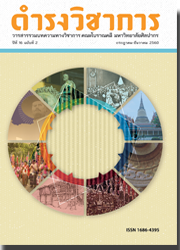The Jutting Leaf Pattern in Dvaravati Art : Source and Relations with Art in Southeast Asia
Keywords:
The jutting leave pattern, Dvaravati art, Pre-Angkorian Khmer artAbstract
The jutting leaf pattern is like a leafy lettuce leaf rolled down. It has a large head which has been gradually lowered to the bottom and the decorations are arranged in a row. The prototype of the pattern may have been derived from the vyalamala pattern of southern India, based on Pallava art, which is used to decorate architecture. This pattern was transformed into a unique feature when it entered South East Asia, becoming a jutting leaf pattern in Cambodia which also found its way into Dvaravati art. In Pre-Angkorian Khmer art, the leaf pattern was used to decorate architecture as well as the architecture of southern India. As for the art of Dvaravati, the pattern is used to decorate architecture and sculpture. From the comparative study of the jutting leaf pattern in Dvaravati art it was found that similar patterns existed in early Khmer art. At the same time, it was found that the jutting leaf pattern in Dvaravati art is different from some earlier Khmer art. This style demonstrates the unraveling and evolution that always occurs in Dvaravati art. It also reflects the context of social and cultural relationship between ancient states of contemporary Southeast Asia.
References
เชษฐ์ ติงสัญชลี, 2559. อาคารทรงศิขระ-วิมานในศิลปะอินเดียกับอิทธิพลต่อศิลปะในเอเชียอาคเนย์. กรุงเทพฯ: ภาควิชาประวัติศาสตร์ศิลปะ คณะโบราณคดี มหาวิทยาลัยศิลปากร.
อมร ศรีพจนารถ, 2536. “บัวหรือลายบัวในศิลปไทย.” ศิลปากร 36 (2): 43-55.
Michael W. Meister., 1983. Encyclopaedia of Indian Temple Architecture South India Lower Dravidadesa 200 B.C.- A.D. 1324. Delhi: Oxford University Press.
Mireille Benisti., 2003. Stylistics of Early Khmer Art. New Delhi: Aryan Book International.
Robert L. Brown., 1996. The Dvaravati Wheel of The Law and The Indianization of South East Asia. Leiden: E.J. Brill.
Downloads
Published
Issue
Section
License
บทความนี้เป็นผลงานของข้าพเจ้าแต่เพียงผู้เดียว และ/หรือเป็นผลงานของข้าพเจ้าและผู้ร่วมงาน ตามชื่อที่ระบุในบทความจริง และเป็นผลงานที่มิได้ถูกนำเสนอหรือตีพิมพ์ที่ใดมาก่อน




